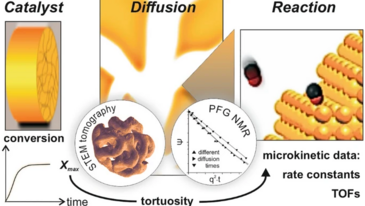Stefan Wild, Christoph Mahr, Andreas Rosenauer, Thomas Risse, Sergey Vasenkov, Marcus Bäumer
Catal Lett (2022)
https://doi.org/10.1007/s10562-022-04218-6
In this article we shed light on newly emerging perspectives to characterize and understand the interplay of diffusive mass transport and surface catalytic processes in pores of gas phase metal catalysts. As a case study, nanoporous gold, as an interesting example exhibiting a well-defined pore structure and a high activity for total and partial oxidation reactions is considered. PFG NMR (pulsed field gradient nuclear magnetic resonance) measurements allowed here for a quantitative evaluation of gas diffusivities within the material. STEM (scanning transmission electron microscopy) tomography furthermore provided additional insight into the structural details of the pore system, helping to judge which of its features are most decisive for slowing down mass transport. Based on the quantitative knowledge about the diffusion coefficients inside a porous catalyst, it becomes possible to disentangle mass transport contributions form the measured reaction kinetics and to determine the kinetic rate constant of the underlying catalytic surface reaction. In addition, predictions can be made for an improved effectiveness of the catalyst, i.e., optimized conversion rates. This approach will be discussed at the example of low-temperature CO oxidation, efficiently catalysed by npAu at 30 °C. The case study shall reveal that novel porous materials exhibiting well-defined micro- and mesoscopic features and sufficient catalytic activity, in combination with modern techniques to evaluate diffusive transport, offer interesting new opportunities for an integral understanding of catalytic processes.


